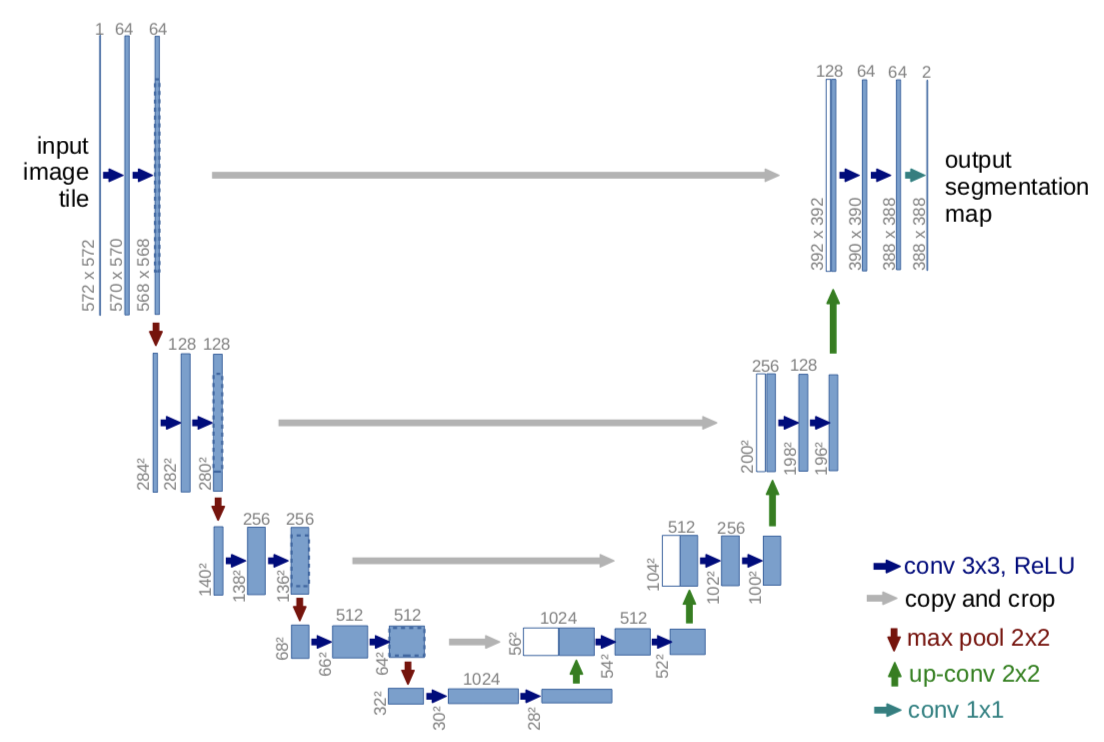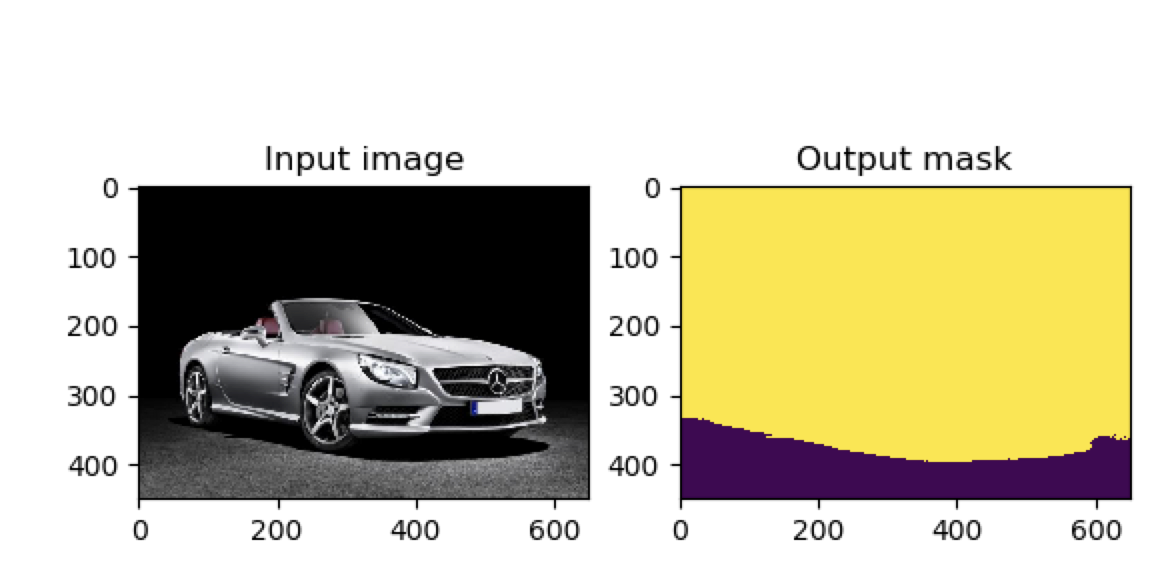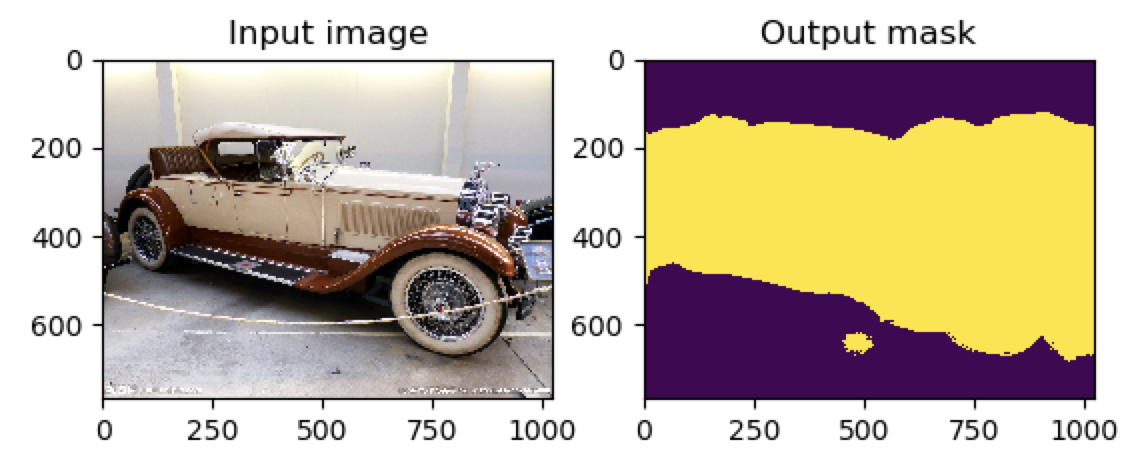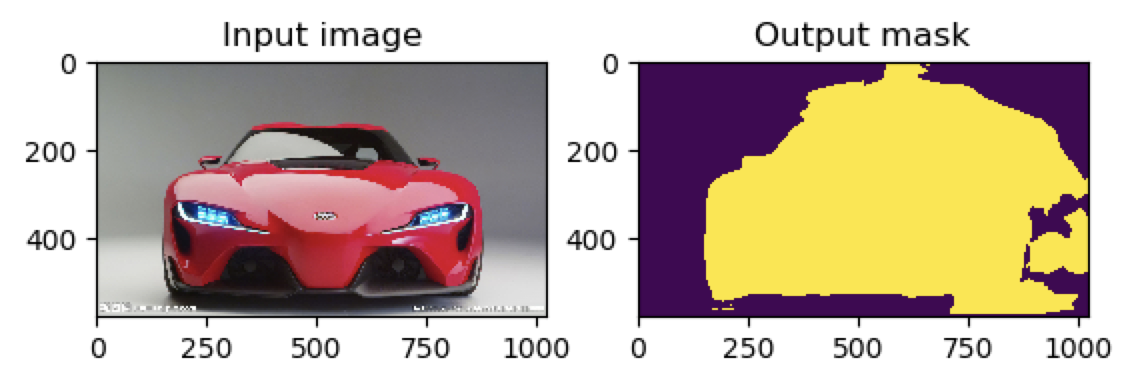参考:https://github.com/milesial/Pytorch-UNet
实现的是二值汽车图像语义分割,包括 dense CRF 后处理.
使用python3,我的环境是python3.6

1.使用
1> 预测
1)查看所有的可用选项:
python predict.py -h
返回:
(deeplearning) userdeMBP:Pytorch-UNet-master user$ python predict.py -h usage: predict.py [-h] [--model FILE] --input INPUT [INPUT ...] [--output INPUT [INPUT ...]] [--cpu] [--viz] [--no-save] [--no-crf] [--mask-threshold MASK_THRESHOLD] [--scale SCALE] optional arguments: -h, --help show this help message and exit --model FILE, -m FILE Specify the file in which is stored the model (default : 'MODEL.pth') #指明使用的训练好的模型文件,默认使用MODEL.pth --input INPUT [INPUT ...], -i INPUT [INPUT ...] #指明要进行预测的图像文件,必须要有的值 filenames of input images --output INPUT [INPUT ...], -o INPUT [INPUT ...] #指明预测后生成的图像文件的名字 filenames of ouput images --cpu, -c Do not use the cuda version of the net #指明使用CPU,默认为false,即默认使用GPU --viz, -v Visualize the images as they are processed #当图像被处理时,将其可视化,默认为false,即不可以可视化 --no-save, -n Do not save the output masks #不存储得到的预测图像到某图像文件中,和--viz结合使用,即可对预测结果可视化,但是不存储结果,默认为false,即会保存结果 --no-crf, -r Do not use dense CRF postprocessing #指明不使用CRF对输出进行后处理,默认为false,即使用CRF --mask-threshold MASK_THRESHOLD, -t MASK_THRESHOLD Minimum probability value to consider a mask pixel #最小化考虑掩模像素为白色的概率值,默认为0.5 white --scale SCALE, -s SCALE Scale factor for the input images #输入图像的比例因子,默认为0.5
2)预测单一图片image.jpg并存储结果到output.jpg的命令
python predict.py -i image.jpg -o output.jpg
测试一下:
(deeplearning) userdeMBP:Pytorch-UNet-master user$ python predict.py --cpu --viz -i image.jpg -o output.jpg Loading model MODEL.pth Using CPU version of the net, this may be very slow Model loaded ! Predicting image image.jpg ... /anaconda3/envs/deeplearning/lib/python3.6/site-packages/torch/nn/modules/upsampling.py:129: UserWarning: nn.Upsample is deprecated. Use nn.functional.interpolate instead. warnings.warn("nn.{} is deprecated. Use nn.functional.interpolate instead.".format(self.name)) /anaconda3/envs/deeplearning/lib/python3.6/site-packages/torch/nn/functional.py:1332: UserWarning: nn.functional.sigmoid is deprecated. Use torch.sigmoid instead. warnings.warn("nn.functional.sigmoid is deprecated. Use torch.sigmoid instead.") Visualizing results for image image.jpg, close to continue ...
返回可视化图片为:

关闭该可视化图片命令就会运行结束:
Mask saved to output.jpg
(deeplearning) userdeMBP:Pytorch-UNet-master user$
并且在当前文件夹中生成名为output.jpg的文件,该图为:

3)预测多张图片并显示,预测结果不存储:
python predict.py -i image1.jpg image2.jpg --viz --no-save
测试:
先得到的是image1.jpg的可视化结果:
(deeplearning) userdeMBP:Pytorch-UNet-master user$ python predict.py -i image1.jpg image2.jpg --viz --no-save --cpu Loading model MODEL.pth Using CPU version of the net, this may be very slow Model loaded ! Predicting image image1.jpg ... /anaconda3/envs/deeplearning/lib/python3.6/site-packages/torch/nn/modules/upsampling.py:129: UserWarning: nn.Upsample is deprecated. Use nn.functional.interpolate instead. warnings.warn("nn.{} is deprecated. Use nn.functional.interpolate instead.".format(self.name)) /anaconda3/envs/deeplearning/lib/python3.6/site-packages/torch/nn/functional.py:1332: UserWarning: nn.functional.sigmoid is deprecated. Use torch.sigmoid instead. warnings.warn("nn.functional.sigmoid is deprecated. Use torch.sigmoid instead.") Visualizing results for image image1.jpg, close to continue ...
图为:

关闭这个后就会接着生成image2.jpg的可视化结果:
Predicting image image2.jpg ... Visualizing results for image image2.jpg, close to continue ...
返回图为:

这时候关闭该可视化服务就会结束了,并且没有在本地保存生成的图片
4)如果你的计算机只有CPU,即CPU-only版本,使用选项--cpu指定
5)你可以指定你使用的训练好的模型文件,使用--mode MODEL.pth
6)如果使用上面的命令选项--no-crf:
(deeplearning) userdeMBP:Pytorch-UNet-master user$ python predict.py -i image1.jpg image2.jpg --viz --no-save --cpu --no-crf
返回的结果是:

还有:

可见crf后处理后,可以将一些不符合事实的判断结果给剔除,使得结果更加精确
2〉训练
python train.py -h
首先需要安装模块pydensecrf,实现CRF条件随机场的模块:
pip install pydensecrf 但是出错:
pydensecrf/densecrf/include/Eigen/Core:22:10: fatal error: 'complex' file not found #include <complex> ^~~~~~~~~ 1 warning and 1 error generated. error: command 'gcc' failed with exit status 1 ---------------------------------------- Failed building wheel for pydensecrf Running setup.py clean for pydensecrf Failed to build pydensecrf
解决办法,参考https://github.com/lucasb-eyer/pydensecrf:
先安装cython,需要0.22以上的版本:
(deeplearning) userdeMBP:Pytorch-UNet-master user$ pip install -U cython Installing collected packages: cython Successfully installed cython-0.29.7
然后从git安装最新版本:
pip install git+https://github.com/lucasb-eyer/pydensecrf.git
但还是没有成功
后面找到了新的方法,使用conda来安装就成功了:
userdeMacBook-Pro:~ user$ conda install -n deeplearning -c conda-forge pydensecrf
-c指明从conda-forge下载模块
conda-forge是可以安装软件包的附加渠道,使用该conda-forge频道取代defaults
因为直接安装conda install -n deeplearning pydensecrf找不到该模块
这时候运行python train.py -h可见支持的选项的信息:
(deeplearning) userdeMBP:Pytorch-UNet-master user$ python train.py -h Usage: train.py [options] Options: -h, --help show this help message and exit -e EPOCHS, --epochs=EPOCHS number of epochs #指明迭代的次数 -b BATCHSIZE, --batch-size=BATCHSIZE batch size #图像批处理的大小 -l LR, --learning-rate=LR learning rate #使用的学习率 -g, --gpu use cuda #使用GPU进行训练 -c LOAD, --load=LOAD load file model #下载预训练的文件,在该基础上进行训练 -s SCALE, --scale=SCALE downscaling factor of the images #图像的缩小因子
3>代码分析
1》unet定义网络
unet/unet_parts.py
# sub-parts of the U-Net model import torch import torch.nn as nn import torch.nn.functional as F #实现左边的横向卷积 class double_conv(nn.Module): '''(conv => BN => ReLU) * 2''' def __init__(self, in_ch, out_ch): super(double_conv, self).__init__() self.conv = nn.Sequential( #以第一层为例进行讲解 #输入通道数in_ch,输出通道数out_ch,卷积核设为kernal_size 3*3,padding为1,stride为1,dilation=1 #所以图中H*W能从572*572 变为 570*570,计算为570 = ((572 + 2*padding - dilation*(kernal_size-1) -1) / stride ) +1 nn.Conv2d(in_ch, out_ch, 3, padding=1), nn.BatchNorm2d(out_ch), #进行批标准化,在训练时,该层计算每次输入的均值与方差,并进行移动平均 nn.ReLU(inplace=True), #激活函数 nn.Conv2d(out_ch, out_ch, 3, padding=1), #再进行一次卷积,从570*570变为 568*568 nn.BatchNorm2d(out_ch), nn.ReLU(inplace=True) ) def forward(self, x): x = self.conv(x) return x #实现左边第一行的卷积 class inconv(nn.Module):# def __init__(self, in_ch, out_ch): super(inconv, self).__init__() self.conv = double_conv(in_ch, out_ch) # 输入通道数in_ch为3, 输出通道数out_ch为64 def forward(self, x): x = self.conv(x) return x #实现左边的向下池化操作,并完成另一层的卷积 class down(nn.Module): def __init__(self, in_ch, out_ch): super(down, self).__init__() self.mpconv = nn.Sequential( nn.MaxPool2d(2), double_conv(in_ch, out_ch) ) def forward(self, x): x = self.mpconv(x) return x #实现右边的向上的采样操作,并完成该层相应的卷积操作 class up(nn.Module): def __init__(self, in_ch, out_ch, bilinear=True): super(up, self).__init__() # would be a nice idea if the upsampling could be learned too, # but my machine do not have enough memory to handle all those weights if bilinear:#声明使用的上采样方法为bilinear——双线性插值,默认使用这个值,计算方法为 floor(H*scale_factor),所以由28*28变为56*56 self.up = nn.Upsample(scale_factor=2, mode='bilinear', align_corners=True) else: #否则就使用转置卷积来实现上采样,计算式子为 (Height-1)*stride - 2*padding -kernal_size +output_padding self.up = nn.ConvTranspose2d(in_ch//2, in_ch//2, 2, stride=2) self.conv = double_conv(in_ch, out_ch) def forward(self, x1, x2): #x2是左边特征提取传来的值 #第一次上采样返回56*56,但是还没结束 x1 = self.up(x1) # input is CHW, [0]是batch_size, [1]是通道数,更改了下,与源码不同 diffY = x1.size()[2] - x2.size()[2] #得到图像x2与x1的H的差值,56-64=-8 diffX = x1.size()[3] - x2.size()[3] #得到图像x2与x1的W差值,56-64=-8 #用第一次上采样为例,即当上采样后的结果大小与右边的特征的结果大小不同时,通过填充来使x2的大小与x1相同 #对图像进行填充(-4,-4,-4,-4),左右上下都缩小4,所以最后使得64*64变为56*56 x2 = F.pad(x2, (diffX // 2, diffX - diffX//2, diffY // 2, diffY - diffY//2)) # for padding issues, see # https://github.com/HaiyongJiang/U-Net-Pytorch-Unstructured-Buggy/commit/0e854509c2cea854e247a9c615f175f76fbb2e3a # https://github.com/xiaopeng-liao/Pytorch-UNet/commit/8ebac70e633bac59fc22bb5195e513d5832fb3bd #将最后上采样得到的值x1和左边特征提取的值进行拼接,dim=1即在通道数上进行拼接,由512变为1024 x = torch.cat([x2, x1], dim=1) x = self.conv(x) return x #实现右边的最高层的最右边的卷积 class outconv(nn.Module): def __init__(self, in_ch, out_ch): super(outconv, self).__init__() self.conv = nn.Conv2d(in_ch, out_ch, 1) def forward(self, x): x = self.conv(x) return x
unet/unetmodel.py
# full assembly of the sub-parts to form the complete net import torch.nn.functional as F from .unet_parts import * class UNet(nn.Module): def __init__(self, n_channels, n_classes): #图片的通道数,1为灰度图像,3为彩色图像 super(UNet, self).__init__() self.inc = inconv(n_channels, 64) #假设输入通道数n_channels为3,输出通道数为64 self.down1 = down(64, 128) self.down2 = down(128, 256) self.down3 = down(256, 512) self.down4 = down(512, 512) self.up1 = up(1024, 256) self.up2 = up(512, 128) self.up3 = up(256, 64) self.up4 = up(128, 64) self.outc = outconv(64, n_classes) def forward(self, x): x1 = self.inc(x) x2 = self.down1(x1) x3 = self.down2(x2) x4 = self.down3(x3) x5 = self.down4(x4) x = self.up1(x5, x4) x = self.up2(x, x3) x = self.up3(x, x2) x = self.up4(x, x1) x = self.outc(x) return F.sigmoid(x) #进行二分类
2》utils
实现dense CRF的代码utils/crf.py:
详细可见pydensecrf的使用
#coding:utf-8 import numpy as np import pydensecrf.densecrf as dcrf def dense_crf(img, output_probs): #img为输入的图像,output_probs是经过网络预测后得到的结果 h = output_probs.shape[0] #高度 w = output_probs.shape[1] #宽度 output_probs = np.expand_dims(output_probs, 0) output_probs = np.append(1 - output_probs, output_probs, axis=0) d = dcrf.DenseCRF2D(w, h, 2) #NLABELS=2两类标注,车和不是车 U = -np.log(output_probs) #得到一元势 U = U.reshape((2, -1)) #NLABELS=2两类标注 U = np.ascontiguousarray(U) #返回一个地址连续的数组 img = np.ascontiguousarray(img) d.setUnaryEnergy(U) #设置一元势 d.addPairwiseGaussian(sxy=20, compat=3) #设置二元势中高斯情况的值 d.addPairwiseBilateral(sxy=30, srgb=20, rgbim=img, compat=10)#设置二元势众双边情况的值 Q = d.inference(5) #迭代5次推理 Q = np.argmax(np.array(Q), axis=0).reshape((h, w)) #得列中最大值的索引结果 return Q
utils/utils.py
import random import numpy as np #将图像分成左右两块 def get_square(img, pos): """Extract a left or a right square from ndarray shape : (H, W, C))""" h = img.shape[0] if pos == 0: return img[:, :h] else: return img[:, -h:] def split_img_into_squares(img): return get_square(img, 0), get_square(img, 1) #对图像进行转置,将(H, W, C)变为(C, H, W) def hwc_to_chw(img): return np.transpose(img, axes=[2, 0, 1]) def resize_and_crop(pilimg, scale=0.5, final_height=None): w = pilimg.size[0] #得到图片的宽 h = pilimg.size[1]#得到图片的高 #默认scale为0.5,即将高和宽都缩小一半 newW = int(w * scale) newH = int(h * scale) #如果没有指明希望得到的最终高度 if not final_height: diff = 0 else: diff = newH - final_height #重新设定图片的大小 img = pilimg.resize((newW, newH)) #crop((left,upper,right,lower))函数,从图像中提取出某个矩形大小的图像。它接收一个四元素的元组作为参数,各元素为(left, upper, right, lower),坐标系统的原点(0, 0)是左上角 #如果没有设置final_height,其实就是取整个图片 #如果设置了final_height,就是取一个上下切掉diff // 2,最后高度为final_height的图片 img = img.crop((0, diff // 2, newW, newH - diff // 2)) return np.array(img, dtype=np.float32) def batch(iterable, batch_size): """批量处理列表""" b = [] for i, t in enumerate(iterable): b.append(t) if (i + 1) % batch_size == 0: yield b b = [] if len(b) > 0: yield b #然后将数据分为训练集和验证集两份 def split_train_val(dataset, val_percent=0.05): dataset = list(dataset) length = len(dataset) #得到数据集大小 n = int(length * val_percent) #验证集的数量 random.shuffle(dataset) #将数据打乱 return {'train': dataset[:-n], 'val': dataset[-n:]} #对像素值进行归一化,由[0,255]变为[0,1] def normalize(x): return x / 255 #将两个图片合并起来 def merge_masks(img1, img2, full_w): h = img1.shape[0] new = np.zeros((h, full_w), np.float32) new[:, :full_w // 2 + 1] = img1[:, :full_w // 2 + 1] new[:, full_w // 2 + 1:] = img2[:, -(full_w // 2 - 1):] return new # credits to https://stackoverflow.com/users/6076729/manuel-lagunas def rle_encode(mask_image): pixels = mask_image.flatten() # We avoid issues with '1' at the start or end (at the corners of # the original image) by setting those pixels to '0' explicitly. # We do not expect these to be non-zero for an accurate mask, # so this should not harm the score. pixels[0] = 0 pixels[-1] = 0 runs = np.where(pixels[1:] != pixels[:-1])[0] + 2 runs[1::2] = runs[1::2] - runs[:-1:2] return runs
utils/data_vis.py实现结果的可视化:
import matplotlib.pyplot as plt def plot_img_and_mask(img, mask): fig = plt.figure() a = fig.add_subplot(1, 2, 1) #先是打印输入的图片 a.set_title('Input image') plt.imshow(img) b = fig.add_subplot(1, 2, 2) #然后打印预测得到的结果图片 b.set_title('Output mask') plt.imshow(mask) plt.show()
utils/load.py
# # load.py : utils on generators / lists of ids to transform from strings to # cropped images and masks import os import numpy as np from PIL import Image from .utils import resize_and_crop, get_square, normalize, hwc_to_chw def get_ids(dir): """返回目录中的id列表""" return (f[:-4] for f in os.listdir(dir)) #图片名字的后4位为数字,能作为图片id def split_ids(ids, n=2): """将每个id拆分为n个,为每个id创建n个元组(id, k)""" #等价于for id in ids: # for i in range(n): # (id, i) #得到元祖列表[(id1,0),(id1,1),(id2,0),(id2,1),...,(idn,0),(idn,1)] #这样的作用是后面会通过后面的0,1作为utils.py中get_square函数的pos参数,pos=0的取左边的部分,pos=1的取右边的部分 return ((id, i) for id in ids for i in range(n)) def to_cropped_imgs(ids, dir, suffix, scale): """从元组列表中返回经过剪裁的正确img""" for id, pos in ids: im = resize_and_crop(Image.open(dir + id + suffix), scale=scale) #重新设置图片大小为原来的scale倍 yield get_square(im, pos) #然后根据pos选择图片的左边或右边 def get_imgs_and_masks(ids, dir_img, dir_mask, scale): """返回所有组(img, mask)""" imgs = to_cropped_imgs(ids, dir_img, '.jpg', scale) # need to transform from HWC to CHW imgs_switched = map(hwc_to_chw, imgs) #对图像进行转置,将(H, W, C)变为(C, H, W) imgs_normalized = map(normalize, imgs_switched) #对像素值进行归一化,由[0,255]变为[0,1] masks = to_cropped_imgs(ids, dir_mask, '_mask.gif', scale) #对图像的结果也进行相同的处理 return zip(imgs_normalized, masks) #并将两个结果打包在一起 def get_full_img_and_mask(id, dir_img, dir_mask): im = Image.open(dir_img + id + '.jpg') mask = Image.open(dir_mask + id + '_mask.gif') return np.array(im), np.array(mask)
3》预测
predict.py使用训练好的U-net网络对图像进行预测,使用dense CRF进行后处理:
#coding:utf-8 import argparse import os import numpy as np import torch import torch.nn.functional as F from PIL import Image from unet import UNet from utils import resize_and_crop, normalize, split_img_into_squares, hwc_to_chw, merge_masks, dense_crf from utils import plot_img_and_mask from torchvision import transforms def predict_img(net, full_img, scale_factor=0.5, out_threshold=0.5, use_dense_crf=True, use_gpu=False): net.eval() #进入网络的验证模式,这时网络已经训练好了 img_height = full_img.size[1] #得到图片的高 img_width = full_img.size[0] #得到图片的宽 img = resize_and_crop(full_img, scale=scale_factor) #在utils文件夹的utils.py中定义的函数,重新定义图像大小并进行切割,然后将图像转为数组np.array img = normalize(img) #对像素值进行归一化,由[0,255]变为[0,1] left_square, right_square = split_img_into_squares(img)#将图像分成左右两块,来分别进行判断 left_square = hwc_to_chw(left_square) #对图像进行转置,将(H, W, C)变为(C, H, W),便于后面计算 right_square = hwc_to_chw(right_square) X_left = torch.from_numpy(left_square).unsqueeze(0) #将(C, H, W)变为(1, C, H, W),因为网络中的输入格式第一个还有一个batch_size的值 X_right = torch.from_numpy(right_square).unsqueeze(0) if use_gpu: X_left = X_left.cuda() X_right = X_right.cuda() with torch.no_grad(): #不计算梯度 output_left = net(X_left) output_right = net(X_right) left_probs = output_left.squeeze(0) right_probs = output_right.squeeze(0) tf = transforms.Compose( [ transforms.ToPILImage(), #重新变成图片 transforms.Resize(img_height), #恢复原来的大小 transforms.ToTensor() #然后再变成Tensor格式 ] ) left_probs = tf(left_probs.cpu()) right_probs = tf(right_probs.cpu()) left_mask_np = left_probs.squeeze().cpu().numpy() right_mask_np = right_probs.squeeze().cpu().numpy() full_mask = merge_masks(left_mask_np, right_mask_np, img_width)#将左右两个拆分后的图片合并起来 #对得到的结果根据设置决定是否进行CRF处理 if use_dense_crf: full_mask = dense_crf(np.array(full_img).astype(np.uint8), full_mask) return full_mask > out_threshold def get_args(): parser = argparse.ArgumentParser() parser.add_argument('--model', '-m', default='MODEL.pth', #指明使用的训练好的模型文件,默认使用MODEL.pth metavar='FILE', help="Specify the file in which is stored the model" " (default : 'MODEL.pth')") parser.add_argument('--input', '-i', metavar='INPUT', nargs='+', #指明要进行预测的图像文件 help='filenames of input images', required=True) parser.add_argument('--output', '-o', metavar='INPUT', nargs='+', #指明预测后生成的图像文件的名字 help='filenames of ouput images') parser.add_argument('--cpu', '-c', action='store_true', #指明使用CPU help="Do not use the cuda version of the net", default=False) parser.add_argument('--viz', '-v', action='store_true', help="Visualize the images as they are processed", #当图像被处理时,将其可视化 default=False) parser.add_argument('--no-save', '-n', action='store_true', #不存储得到的预测图像到某图像文件中,和--viz结合使用,即可对预测结果可视化,但是不存储结果 help="Do not save the output masks", default=False) parser.add_argument('--no-crf', '-r', action='store_true', #指明不使用CRF对输出进行后处理 help="Do not use dense CRF postprocessing", default=False) parser.add_argument('--mask-threshold', '-t', type=float, help="Minimum probability value to consider a mask pixel white", #最小概率值考虑掩模像素为白色 default=0.5) parser.add_argument('--scale', '-s', type=float, help="Scale factor for the input images", #输入图像的比例因子 default=0.5) return parser.parse_args() def get_output_filenames(args):#从输入的选项args值中得到输出文件名 in_files = args.input out_files = [] if not args.output: #如果在选项中没有指定输出的图片文件的名字,那么就会根据输入图片文件名,在其后面添加'_OUT'后缀来作为输出图片文件名 for f in in_files: pathsplit = os.path.splitext(f) #将文件名和扩展名分开,pathsplit[0]是文件名,pathsplit[1]是扩展名 out_files.append("{}_OUT{}".format(pathsplit[0], pathsplit[1])) #得到输出图片文件名 elif len(in_files) != len(args.output): #如果设置了output名,查看input和output的数量是否相同,即如果input是两张图,那么设置的output也必须是两个,否则报错 print("Error : Input files and output files are not of the same length") raise SystemExit() else: out_files = args.output return out_files def mask_to_image(mask): return Image.fromarray((mask * 255).astype(np.uint8)) #从数组array转成Image if __name__ == "__main__": args = get_args() #得到输入的选项设置的值 in_files = args.input #得到输入的图像文件 out_files = get_output_filenames(args) #从输入的选项args值中得到输出文件名 net = UNet(n_channels=3, n_classes=1) #定义使用的model为UNet,调用在UNet文件夹下定义的unet_model.py,定义图像的通道为3,即彩色图像,判断类型设为1种 print("Loading model {}".format(args.model)) #指定使用的训练好的model if not args.cpu: #指明使用GPU print("Using CUDA version of the net, prepare your GPU !") net.cuda() net.load_state_dict(torch.load(args.model)) else: #否则使用CPU net.cpu() net.load_state_dict(torch.load(args.model, map_location='cpu')) print("Using CPU version of the net, this may be very slow") print("Model loaded !") for i, fn in enumerate(in_files): #对图片进行预测 print(" Predicting image {} ...".format(fn)) img = Image.open(fn) if img.size[0] < img.size[1]: #(W, H, C) print("Error: image height larger than the width") mask = predict_img(net=net, full_img=img, scale_factor=args.scale, out_threshold=args.mask_threshold, use_dense_crf= not args.no_crf, use_gpu=not args.cpu) if args.viz: #可视化输入的图片和生成的预测图片 print("Visualizing results for image {}, close to continue ...".format(fn)) plot_img_and_mask(img, mask) if not args.no_save:#设置为False,则保存 out_fn = out_files[i] result = mask_to_image(mask) #从数组array转成Image result.save(out_files[i]) #然后保存 print("Mask saved to {}".format(out_files[i]))
4》训练
import sys import os from optparse import OptionParser import numpy as np import torch import torch.backends.cudnn as cudnn import torch.nn as nn from torch import optim from eval import eval_net from unet import UNet from utils import get_ids, split_ids, split_train_val, get_imgs_and_masks, batch def train_net(net, epochs=5, batch_size=1, lr=0.1, val_percent=0.05, save_cp=True, gpu=False, img_scale=0.5): dir_img = 'data/train/' #训练图像文件夹 dir_mask = 'data/train_masks/' #图像的结果文件夹 dir_checkpoint = 'checkpoints/' #训练好的网络保存文件夹 ids = get_ids(dir_img)#图片名字的后4位为数字,能作为图片id #得到元祖列表为[(id1,0),(id1,1),(id2,0),(id2,1),...,(idn,0),(idn,1)] #这样的作用是后面重新设置生成器时会通过后面的0,1作为utils.py中get_square函数的pos参数,pos=0的取左边的部分,pos=1的取右边的部分 #这样图片的数量就会变成2倍 ids = split_ids(ids) iddataset = split_train_val(ids, val_percent) #将数据分为训练集和验证集两份 print(''' Starting training: Epochs: {} Batch size: {} Learning rate: {} Training size: {} Validation size: {} Checkpoints: {} CUDA: {} '''.format(epochs, batch_size, lr, len(iddataset['train']), len(iddataset['val']), str(save_cp), str(gpu))) N_train = len(iddataset['train']) #训练集长度 optimizer = optim.SGD(net.parameters(), #定义优化器 lr=lr, momentum=0.9, weight_decay=0.0005) criterion = nn.BCELoss()#损失函数 for epoch in range(epochs): #开始训练 print('Starting epoch {}/{}.'.format(epoch + 1, epochs)) net.train() #设置为训练模式 # reset the generators重新设置生成器 # 对输入图片dir_img和结果图片dir_mask进行相同的图片处理,即缩小、裁剪、转置、归一化后,将两个结合在一起,返回(imgs_normalized, masks) train = get_imgs_and_masks(iddataset['train'], dir_img, dir_mask, img_scale) val = get_imgs_and_masks(iddataset['val'], dir_img, dir_mask, img_scale) epoch_loss = 0 for i, b in enumerate(batch(train, batch_size)): imgs = np.array([i[0] for i in b]).astype(np.float32) #得到输入图像数据 true_masks = np.array([i[1] for i in b]) #得到图像结果数据 imgs = torch.from_numpy(imgs) true_masks = torch.from_numpy(true_masks) if gpu: imgs = imgs.cuda() true_masks = true_masks.cuda() masks_pred = net(imgs) #图像输入的网络后得到结果masks_pred,结果为灰度图像 masks_probs_flat = masks_pred.view(-1) #将结果压扁 true_masks_flat = true_masks.view(-1) loss = criterion(masks_probs_flat, true_masks_flat) #对两个结果计算损失 epoch_loss += loss.item() print('{0:.4f} --- loss: {1:.6f}'.format(i * batch_size / N_train, loss.item())) optimizer.zero_grad() loss.backward() optimizer.step() print('Epoch finished ! Loss: {}'.format(epoch_loss / i)) #一次迭代后得到的平均损失 if 1: val_dice = eval_net(net, val, gpu) print('Validation Dice Coeff: {}'.format(val_dice)) if save_cp: torch.save(net.state_dict(), dir_checkpoint + 'CP{}.pth'.format(epoch + 1)) print('Checkpoint {} saved !'.format(epoch + 1)) def get_args(): parser = OptionParser() parser.add_option('-e', '--epochs', dest='epochs', default=5, type='int', #设置迭代数 help='number of epochs') parser.add_option('-b', '--batch-size', dest='batchsize', default=10, #设置训练批处理数 type='int', help='batch size') parser.add_option('-l', '--learning-rate', dest='lr', default=0.1, #设置学习率 type='float', help='learning rate') parser.add_option('-g', '--gpu', action='store_true', dest='gpu', #是否使用GPU,默认是不使用 default=False, help='use cuda') parser.add_option('-c', '--load', dest='load', #下载之前预训练好的模型 default=False, help='load file model') parser.add_option('-s', '--scale', dest='scale', type='float', #图像的缩小因子,用来重新设置图片大小 default=0.5, help='downscaling factor of the images') (options, args) = parser.parse_args() return options if __name__ == '__main__': args = get_args() #得到设置的所有参数信息 net = UNet(n_channels=3, n_classes=1) if args.load: #是否加载预先训练好的模型 net.load_state_dict(torch.load(args.load)) print('Model loaded from {}'.format(args.load)) if args.gpu: #是否使用GPU,设置为True,则使用 net.cuda() # cudnn.benchmark = True # faster convolutions, but more memory try: #开始训练 train_net(net=net, epochs=args.epochs, batch_size=args.batchsize, lr=args.lr, gpu=args.gpu, img_scale=args.scale) except KeyboardInterrupt: #如果键盘输入ctrl+c停止,则会将结果保存在INTERRUPTED.pth中 torch.save(net.state_dict(), 'INTERRUPTED.pth') print('Saved interrupt') try: sys.exit(0) except SystemExit: os._exit(0)